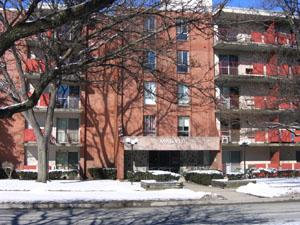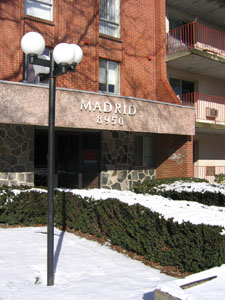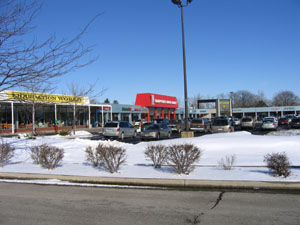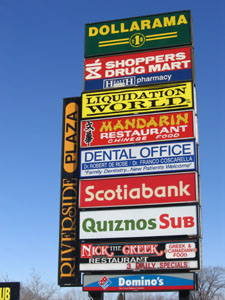
Eastern Windsor, Ontario, Canada
by Shawn Micallef
Windsor, Ontario sits across the river from Detroit. The east side of Windsor, upriver, gets me thinking about cocktail parties, Tupperware parties, quiet Pierre Trudeau support and Windsor people getting married and living in their first apartments. I get this feeling when I drive through there now – it’s derived from a few photographs and some yellow tinted memories I have from the mid to late 70s. It’s nostalgia for an era that I didn’t really participate in, but one that is very much part of Windsor for me. It’s a happy, clean, straight, 6-cylinder vision.
In 1971 my parents were newly married and moved into the Madrid Apartments. It’s a low rise building, maybe five or six stories, red brick, balconies – a ubiquitous semi-urban slab that in no way resembles the Spanish capital – but that’s half the fun. Maybe I’m just a sucker for a geographical reference, but I prefer this over the faux-grand names used today like “The Pinnacle”. The building is right near the terminus of Wyandotte Street, and sits in the middle of about 4 blocks of similar apartments, all built during the 1960s. Some of them are U shaped and feature an outdoor pool in the interior courtyard.
These aren’t great buildings or notable in anyway by themselves, but I attach this sort of cozy happiness to them – everybody out on a hot July afternoon, surrounding the communal pool, BBQing hotdogs, drinking Labatts 50 in stubby bottles listening to the Big 8’s 50,000 watts of AM power. In the pictures from this era, say 1966 until 1974, when I was born, Windsor seems like an oasis of calm and full employment. Unlike much of Tecumseh Road or Huron Church, wide arterial roads that cut through the city which have become big-box East Side Mario wastelands, Wyandotte Street East has retained much of its post war features. I don’t think UNESCO should rush in and declare the area a world heritage site, but as Windsor goes, it’s quite nice and those cheap awful commercial joints out on Walker Road near the Silver City could take some style cues from this area on how to maintain a level of human scale even when catering to a city where the car is king.
The Riverside Plaza, just East of Lauzon, fits in with this near utopic vision. Despite the massive parking lot, I have a soft spot for this place. Though by the time I was born my parents had moved the family out to the Tecumseh suburbs, my mom maintained an account at the Scotiabank in the plaza, so we had reason to go there. While there we’d often go visit the pet shop located in the corner. We once took home a dog named Sandy sometime around 1977, but we had to return her the next day at the behest of my father. In the mid 1980s the Maltese Club of Windsor was housed in one of the plaza’s units as well. I didn’t go there much, but it was one of those smokey little ethnic pockets that mean a great deal to a particular community but are so often located in nowhere locations like strip malls.
I liked going into the IGA that was there too. It had this weird wall near the entrance made out of boulders. Maybe it was fake, I don’t know – today I would say something like blah-blah-inspired by Frank Lloyd Wright’s use of natural rock-blah-blah, but I just thought it was really neat then. It was. The builders were at least trying. That counts. Today it has a big sign outside that says “Liquidation Centre”.
At some point I’ve selectively forgot about the banal times, the rainy days, the complaints or the waiting in lines. Everyday I remember as being brilliantly sunny, perpetually August, me wearing shorts and happy to be on a trip into the City. Windsor was more bustling, exotic and jammed together than Tecumseh, and that’s also what counted.
During the 1990s I’d ride my bike from Tecumseh into Windsor, making my way along the gravel path that ran beside the CN Tracks to the Ganatchio Trail (it’s gone now, part of the Forest Glade style development going in between the lake and Tecumseh Road). I’d ride up and down the streets adjacent to the Madrid, through the parking lot of the plaza, along the footpaths carved out of the empty lots, and West along Wyandotte towards the city center.
I’d wonder who lives in these places now? Do the new couples take the same benign happy pictures my parents did? Do they look confidently into the future too? I try and reconcile the Windsor of today with my secret one, the one that I suspect exists only in my head, where the dads go off each morning to Hiram Walker & Sons and work for a company where everybody is treated like family, where moms take their kids back to visit the girls at the Windsor Utilities, the ones who didn’t quit to have children. Do they eat pizza at the Riverside Tavern every Saturday night? Do they drive to Point Pelee in the summer with relatives from Malta? Yearly trips to Boblo for the company picnic?
These images are often at odds with what was going on in the world, or even next door. My father has often recalled standing on the Hiram Walker grounds in July of 1967 looking over at Detroit as the city burned and the National Guard tanks rolled down Jefferson during the riots. Windsor sits as close as possible to the finest example of modernism gone wrong, yet maintains a safe distance from it, letting us peer into the heart of darkness at our leisure. It’s a good perspective to have, perhaps one of the most valuable commodities Windsor manufactures. As long as Windsor maintains this sense of order, the one I see when I drive along Wyandotte, the city will be alright.
Shawn Micallef runs the web- and blogsite Toronto Psychogeography Society, which can be viewed at psychogeography.ca.




